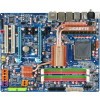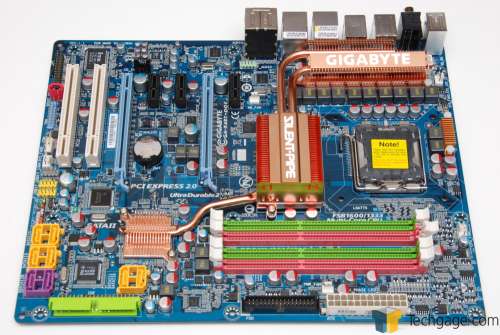- Qualcomm Launches Snapdragon 4 Gen 2 Mobile Platform
- AMD Launches Ryzen PRO 7000 Series Mobile & Desktop Platform
- Intel Launches Sleek Single-Slot Arc Pro A60 Workstation Graphics Card
- NVIDIA Announces Latest Ada Lovelace Additions: GeForce RTX 4060 Ti & RTX 4060
- Maxon Redshift With AMD Radeon GPU Rendering Support Now Available
Gigabyte GA-X48T-DQ6

Building a new machine and want DDR3 support? Then the X48T-DQ6 should be up for consideration. It offers great performance, very stable high overclocks (500MHz) and lots of connectivity, including a full eight USB ports at the back. The layout is not ideal, but the board still proves good overall.
Page 10 – Final Thoughts
|
|
The X48T-DQ6 retails for around $330… so is it worth it? Hard to say. At $300, it would be a lot easier to recommend the board, as it supports DDR3 and is really quite feature-packed, on top of having a good overclocking ability. But $330 is a lot to devote to a motherboard, especially with P45 right around the corner.
In our initial P45 tests, however, overclocking is not as stellar as X38/X48, but whether or not that just happens to be our sample (ASUS P5Q Deluxe) or not, I’m not sure. But it still begs the question, should a brand-new motherboard be purchased now with P45 coming out in less than a month?
Well at this point, we are unsure where P45 is going to stand in the marketplace. P35, when released last spring, was designed to be a mid-range product, which is why there are products available for well under $100, and also above $200. X38 was then launched as a high-end enthusiast’s offering, which is why boards are far closer to $300. So if there is a P45, is there going to be an X55?
It’s hard to say at this point, but there’s been no leaks so far. If our P45 testing is representative of all boards with such that chipset, it will be lacking in overclocking-ability. However, I can say at this point that P45 seems to be more power efficient, but we need to investigate whether the drop is due to the chipset or ASUS’ EPU chip. More on that in an article later this week.
That tangent aside, I have no issues recommending this board. It performed well alongside our other X38/X48 offerings, overclocked to 500MHz FSB without a hitch, looks great and includes lots of functionality. The fact that eight USB ports are available right out of the box is nice, and the same goes for the eight S-ATA ports.
Overall, I liked the layout the board offered, with the two caveats I mentioned earlier. I have no idea who could design this board and not realize the 8-pin motherboard connector is a chore to deal with. It’s difficult to remove the protector, difficult to plug the power in and likewise difficult to remove it.
The other potential issue is with the slot layout, for those who want to use Crossfire mode. If you have single-slot GPUs, you are fine, but if you don’t, then the first PCI slot will be cut off. This might not be a problem for some, but many use both an add-on card and also a WiFi, so that would tie them both up and as a result, make Crossfire not possible with dual-slot cards.
The lesson is simple. Begin buying what you can in PCI-E 1x. Motherboard manufacturers, for whatever reason, continue to focus on those, so it might be a good idea to purchase such cards where possible. Sound cards and WiFi cards are starting to creep up in PCI-E 1x, and we can only expect more and more peripherals to follow suit.
For those not willing to splurge well over $300 for a board (along with DDR3), the X48-DQ6 board is identical to this one, except that it uses DDR2. It also retails for $40 less than this one, so I’d have no problem recommending that over this one. Unless for some reason you really need DDR3 (which you don’t).
-
Pros
- Great performance, on par with other X48 boards
- Lots of connectivity: 2x LAN, 8x USB, 8x S-ATA, 2x Firewire
- Hits 500MHz stable (Dual-Core) and 465MHz (Quad-Core) without issue
-
Cons
- Little expensive ($330)
- 8-Pin power connector is in a bad location
- Using GPUs with dual-slot GPUs will lose you a PCI
If you have a comment you wish to make on this review, feel free to head on into our forums! There is no need to register in order to reply to such threads.
|
|
Support our efforts! With ad revenue at an all-time low for written websites, we're relying more than ever on reader support to help us continue putting so much effort into this type of content. You can support us by becoming a Patron, or by using our Amazon shopping affiliate links listed through our articles. Thanks for your support!






